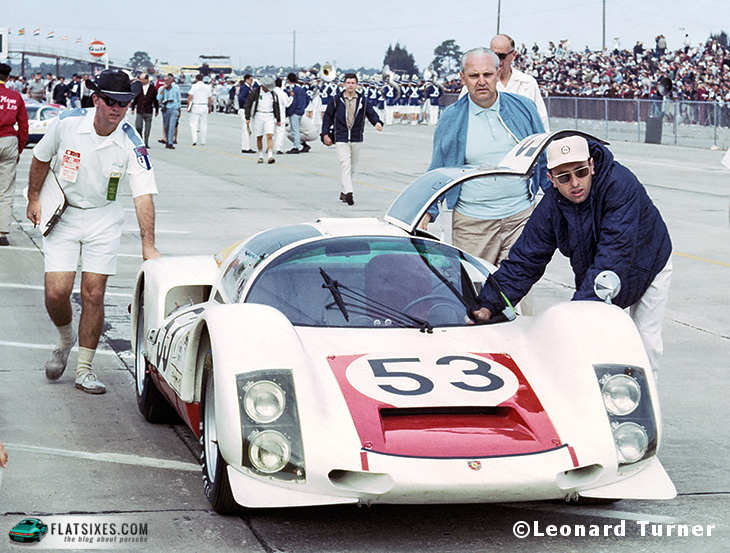Sebring 1966, 50 years ago: Porsche’s newest, in what was to be a long string of prototype racers, is being pushed to the grid in front of a huge crowd with a band playing in the background. Herbert Dramm, a well-known Porsche engineer assigned to the US and a great friend to many Porsche owners here, follows with a look of concern, perhaps wondering if this 906, which had qualified an incredible 15 seconds faster than last year’s eight-cylinder 904, could make it for the 12 hours to come. The two-liter Dino Ferrari was almost as fast, and the war between the much more powerful big Fords and Ferraris was heating up, promising a chaotic contest.

Pushing his own car to the grid (when was the last time you saw that?) is 30 year old Gerhard Mitter (an F1 and sports car pilot who would go on to win both the Targa Florio and the 24 Hour at Daytona for Porsche). Mitter would also come to be known as the European Hillclimb Champion in Porsches later this year and for the two years after as well, memorably once winning with his leg in a cast. Mitter appears unconcerned; no stranger to small displacement Porsches, he had scored Formula One points with an old Porsche 718, had driven the eight-cylinder 904 here the previous year, and had, with Joe Buzzetta, placed well in a 904 at the 24 hour Daytona race the previous month. Just another day at the office.
But of course it was not just another day, another Sebring race. Five people died that day; Canadian driver Bob McLean in a GT40 and in an unrelated accident, four spectators in a highly dangerous, uncontrolled area. Sebring’s administration was severely criticized, and plans—later shelved–were made to move the race to an entirely different venue.
Dan Gurney’s splendid run in one of the seven-liter Fords ended in the last few seconds of a 12-hour race that it had seemed clear he would win. His engine gave up a few hundred feet from the finish line and his effort to push the car to the finish converted what would have become a second place to a disqualification.
And Gerhard Mitter’s #53 906, the top qualifier in class, gave out after 120 laps. At least one observer suggested that the brilliant qualification run, only nine seconds off the overall Sebring lap record set by Gurney in the Ford Mark II, had over-stressed the little engine. The bright spot was that the sister 906, #52, on which Mitter was the third driver (along with Hans Hermann and Joe Buzzetta), denied the Ferrari Dino the class win by finishing fourth overall behind the three Fords that swept the field, putting four two-liter Porsches–three 906s and one 904–in the top eight finishers.
